Search
03/21: Sheroes of sustainability in the Mediterranean
This special feature prepared by UNEP/MAP-SPA/RAC on the occasion of International Women’s Day aims to highlight the accomplishments of some (among many) of the everyday female heroes who embody the principles enshrined in the Barcelona Convention through their work.
Winning hearts and minds in the National Marine Park of Karaburun-Sazan
A story from Karaburun-Sazan, Albania, prepared for the observance of the 2021 edition of International Women’s Day

Lorela Lazaj ©AdZM Vlore
The National Marine Park of Karaburun-Sazan covers the marine area along the coastlines of Karaburuni peninsula and Sazani island in Albania. It is a Marine Protected Area (MPA) that was established in 2010, five years prior to the creation of the National Agency of Protected Areas (NAPA). This posed management challenges as a single office in the Ministry of the Environment had to oversee conservation in the entire Albanian territory, according to Lorela Lazaj, the Director of the Regional Administration of Protected Areas in Vlora region (RAPA Vlora).
"For five years there was no proper management in the MPA", Ms. Lazaj, who is responsible for the management of six protected areas in the Vlora region, observes. When the regional offices were finally set up within NAPA in 2015, a newly established team led by Ms. Lazaj set about laying the groundwork for the effective and sustainable management in the protected areas under their remit.
One of the main hurdles that the team had to overcome was the local communities’ scepticism. To demonstrate the importance of conservation to ambivalent fishers whose subsistence depends on the MPA resources, the team put their Communication for Development skills to good use: "protected areas are not a forbidden territory—by conserving biodiversity they can support livelihoods and yield greater benefits for the community".

Brisani Bay ©AdZM Vlore
Ms. Lazaj admits that convincing local communities was far from being plain sailing. "The most important thing is to build and maintain trust. If they feel that you are doing this wholeheartedly, they will believe you and will be on your side then", Ms. Lazaj prescribes, adding that "with my colleagues we managed to build a successful management model where women have a leading and managerial role in nature protection and monitoring".

The fieldwork ©AdZM Vlore
According to Ms. Lazaj, "working in the field of monitoring and environmental management is sometimes seen as more suitable for men" but she reports that her team’s professionalism has shattered this antiquated stereotypical perception among the communities living in and around the protected areas in the Vlora region.
Despite restrictions linked to COVID-19, learning and dialogue continue so that the various users of MPAs become more involved in the thinking that underpins conservation work and sustainable development.
"The MPA is not ours, this area belongs to everyone. So, it’s not just about management or regulation. It’s about providing wellbeing for everyone, a good environment, food and resources for the generations to come".
![]() The National Marine Park of Karaburun-Sazan
The National Marine Park of Karaburun-Sazan
The National Marine Marine Park Karaburun-Sazan covers the marine area along the coastlines of Karaburuni peninsula and Sazani island, located in the Southern Albania, Vlora Municipality.
For almost half a century a military zone, declared a Protected Marine Area in 2010, the Karaburun-Sazan Park is one of Albania’s best protected sites.
It hosts at least 36 marine species belonging to the international list of endangered or protected species. The park hosts 75% of the national endangered species of marine animals mostly benthic macroinvertebrates, and 220 marine plant species. Posidonia oceanica meadow, Red coral and Cystoseira amentacea are considered priority habitats by the EU Habitats Directive and are also listed in the Annex II and III of the Barcelona Convention (as endangered or threatened species, or species whose exploitation is required).
On the coast and underwater, many archaeological and historical ruins also make this site of cultural interest. South-west of the Karaburun Peninsula, in Grama Bay, an old port can be seen, and on the nearby rocks many inscriptions, engraved on the rock face, date back two thousand years.
For more information: www.akzm.gov.al
***
The MPA leader who’s taking marine sustainability ashore
A story from Tyre, Lebanon, prepared for the observance of the 2021 edition of International Women's Day

Nahed Msayleb
The Tyre Coast Nature Reserve in Lebanon is included in the List of Specially Protected Areas of Mediterranean Importance (SPAMI List) since 2013. The reserve underwent a study in 2019 to establish whether it still meets the criteria of the SPA/BD Protocol’s Annex I, including those related to management. The study identified several issues and the reserve was placed in a "period of a provisional nature"—a technical term used for sites that must enhance management in a pre-determined timeframe to keep the SPAMI label. Since then the management team in Tyre has tirelessly worked to bridge the gaps, including through an updated management plan. "It was quite tough, we passed hardly", Nahed Msayleb, the Director of the Reserve since 2018, recalls with relief.
Before taking the reins, Ms. Msayleb had been a member of the Reserve’s committee for 15 years. "The reserve inspired me to take a master’s degree in environmental engineering", she declares when speaking of her continued fascination with the natural beauty of the site and its unique biodiversity.
She decided from the outset that her mission was to lead the reserve towards sustainability while considering societal, economic and environmental aspects. "I base all my proposals, all my projects and activities on these three pillars, because I understand that any endeavor omitting one of them would be doomed".
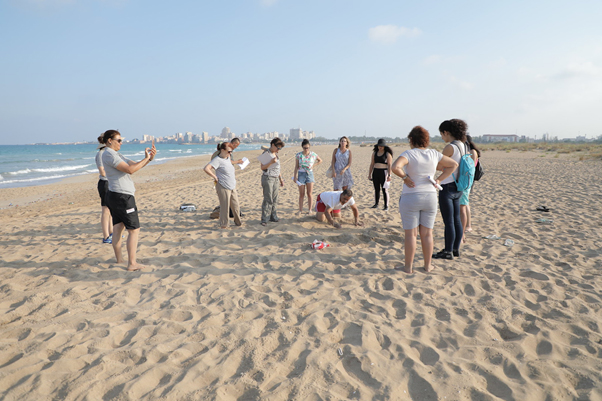
Training on marine turtle monitoring in the Tyre Coast Nature Reserve ©SPA/RAC
For Ms. Msayleb, the SPAMI label is an important asset. It helps in raising awareness of the site’s endangered natural heritage and in mobilizing the human and financial resources needed to safeguard it. "Several studies have already been conducted and will be used as a foundation for the new management plan, which is the basis for the management and development of the reserve". The studies focus on the status of the ecosystems, the important bird population, but also on the use of natural resources and the socio-economic issues.
Citing three projects that the SPAMI is benefiting from, Ms. Msayleb explained that those projects generally help to better preserve and manage the natural heritage but can also boost the local economy. She mentioned the COMMON project, focusing on marine litter management, and MED4EBM, the Mediterranean Forum For Applied Ecosystem-Based Management under the ENI CBC Med programme. As part of the IMAP-MPA project Ms. Msayleb and the reserve team are fully involved in updating the management plan of Tyre Coast Nature Reserve and its effective implementation (the MPA component of the IMAP-MPA project is executed by UNEP/MAP-SPA/RAC and financially supported by the European Union).
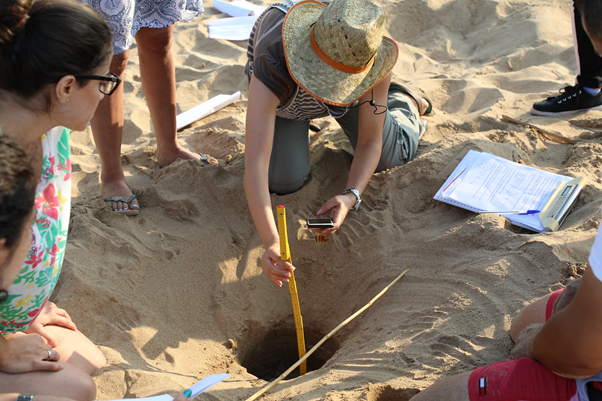
Marine turtle nesting site monitoring in the Tyre Coast Nature Reserve ©SPA/RAC
For Ms. Msayleb, dialogue with fishers for the promotion of sustainable fishing in Tyre is crucial: "practice made them see and touch the tangible benefits of sustainability", she declares while citing the Drosos project implemented by IUCN in cooperation with the local fishers’ association in Tyre.
The Director aspires to replicating success with other stakeholders at sea and on land in the rural area of the reserve. "By promoting sustainable agriculture, we try to create a package of farming guidelines that the farmers of Ras El Ain can use to produce healthier products". Acquiring a label of sustainability puts an added value on the produce, making it more marketable and therefore more profitable.
Sometimes, Ms. Msayleb observes, ideas are met with resistance that may find its roots in gender-related bias. But she remains determined to pursue her vision for the reserve.
Her priority remains engaging effectively with the users of natural resources and all stakeholders. "If you don’t consider the local community, the MPA may look like a paradise, but it will fail to fulfil its purpose: delivering sustainable local development in harmony with nature", she insightfully observes.
![]() The Tyre Coast Nature Reserve
The Tyre Coast Nature Reserve
Tyre Coast Nature Reserve is not only a Nature reserve but also a SPAMI and Ramsar site. Located in Southern Lebanon expanding over 380 ha, Tyre Coast Nature Reserve remains the largest sandy beach in Lebanon. It is a nesting site for the endangered Loggerhead and Green turtle and the shelter of many other rare species.
Here is a guided tour of the Tyre Coast Nature Reserve, streamed live on Sep 9, 2020 by Anthony Rahayel:
For more information : Facebook page of the Tyre Coast Nature Reserve
***
The fisherwoman who conquered her fear and made peace with nature
A story from Kerkennah, Tunisia, prepared in collaboration with Hamed Mallat and Imed Guetat, for the observance of the 2021 edition of International Women's Day

Salha el-Bouri and the insignia of the Order of the Republic of Tunisia ©SPA/RAC, Hamed Mallat
Salha Bent El-Bouri is a celebrity in Kerkennah, Tunisia, where she was born in 1933 and where she returned at the age of forty to take up a new career as a fisherwoman. "My relatives encouraged me to use the ‘Charfia’, so I followed their advice".
Charfia fishing in the Kerkennah Islands is a traditional, passive fishing technique consisting of palm fronds embedded in the seabed to create a triangular barrier, blocking the path of the fish pulled in by the ebb tide and channelling them into capture chambers and finally into a net or trap. Unlike bottom trawling systems that scrape the seabed, the traps keep the fish alive and fasting until raised.
Since then, the Charfia and net fishing have become the source of her income. "I check in the morning and in the evening, and I always find something". Salha Bent El-Bouri bags the fish and releases other species that she knows should not be caught. Sometimes, she would have a close encounter with a marine turtle and other unexpected types of catch. This has shaped her attitude towards marine animals.
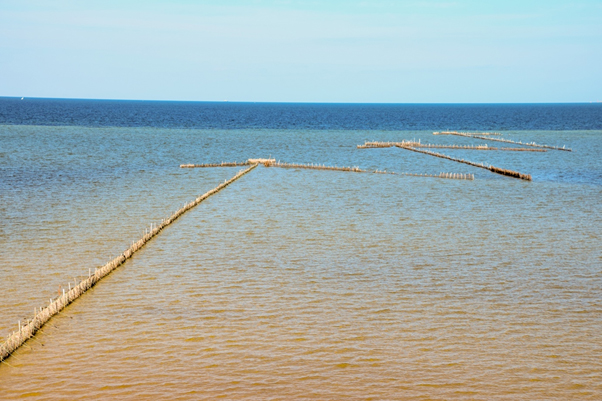
Charfia ©SPA/RAC, Hamed Mallat
Being in contact with marine animals has not always been easy for her. "I had this fear of the octopus and used to bring another woman with me to help me catch them", she confesses. "This went on for years until, suddenly, I was no longer afraid". She recounts how, one day, a juggernaut of a specimen almost caused her boat to capsize. "The octopus put up a good fight. I fought back for an hour. I managed to get the best of it and took it home. It weighed 13 kilos".
The risk-fraught tussle with the octopus encouraged Salha Bent El-Bouri to take steps to obtain her seafarers' card and insurance. "I have seven children who depend on me. If I die, they would at least receive some money to live on". She obtained an official document reading "female captain of a fishing boat" rather easily. Her reputation as a strong, independent woman was already well established.

Kerkennah ©SPA/RAC, Hamed Mallat
Ms. Salha has long heard of the project to create a Marine and Coastal Protected Area (MCPA) in Kerkennah. Like several other sites in Tunisia, the northern islets of the archipelago have not yet been officially declared as an MCPA, but the process is underway. For her, the archipelago must be protected. "The fish used to be very abundant. Not anymore. Trawls, illegal fishing and selfishness are the source of this problem", she reckons.
According to her, the most important thing is enlisting the support of the fishers and improving their living conditions. "Anything is possible, but we must be united. Without joining forces, without mutual support, nothing will happen and Kerkennah archipelago will suffer".
Salha Bent El-Bouri treasures pictures of her with the late Tunisian President Béji Caïd Essebsi awarding her the insignia of the Order of the Republic of Tunisia. When she received the phone call inviting her to the Presidential Palace in Carthage, 350 km away, she told her interlocutor that she would come "if not by land, by sea - I have a navigation permit".
![]() The future Marine and Coastal Protected Area of Kerkennah
The future Marine and Coastal Protected Area of Kerkennah
Currently, the MPA component of the IMAP-MPA project "Towards achieving the Good Environmental Status of the Mediterranean Sea and Coast through an Ecologically Representative and Efficiently Managed and Monitored Network of Marine Protected Areas" funded by the European Union and executed by UNEP/MAP-SPA/RAC will support specific activities aiming at setting up the local management unit and initiating the implementation of the management plan of the future MPA, already prepared within the MedMPA Network project, financed as well by the European Union.
In that respect, an integrated socio-economic programme for the management of the sustainable fishing including artisanal techniques such as "Charfia" and the effective surveillance and monitoring of the site will be developed and enhanced.
Watch this short video, produced within the UE-funded MedMPAnet project, to know more about the Charfia.
***
The fisherwoman at the helm in Gokova Bay
A story from Gokova Bay, Turkey, prepared in collaboration with the Mediterranean Conservation Society (MCS) for the observance of the 2021 edition of International Women’s Day
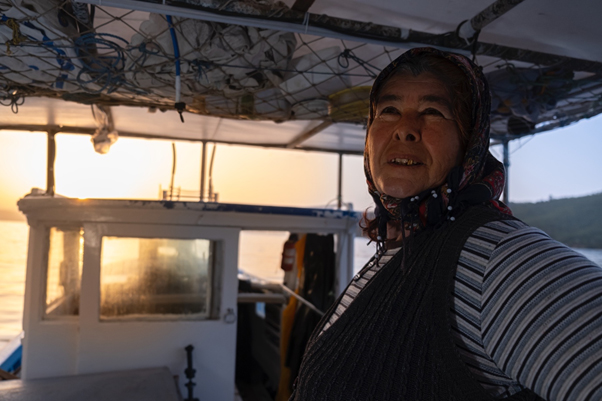
Gulsiye Olmez ©SPA/RAC, Bubi Film
Fisherwomen in Turkey have thrown nets at sea for centuries. Traditional fishing bears witness to the harmonious relationship that can bond humans with nature. But nowadays the traditional brand of catching fish for a living must reckon with multiple threats: illegal and mass fishing practices, the increasingly conspicuous presence of non-indigenous species and other, ever more perceptible effects of climate change.
Fisherwomen also face other issues related to gender roles aboard fishing boats. In a profession still widely dominated by men, female crew members have long been legion, and women captains few and far between. Women’s calls for gender equality are finally bringing about a sea change in the traditional fishing business.
Gulsiye Olmez, a fisherwoman from Akbuk in Gokova Bay, a Marine Protected Area (MPA) in Turkey, is the captain of her own boat. Ms. Olmez has been fishing in Gokova Bay since 1982 and learned the craft from her husband. Three decades ago, the pair chose to fish together and never looked back.
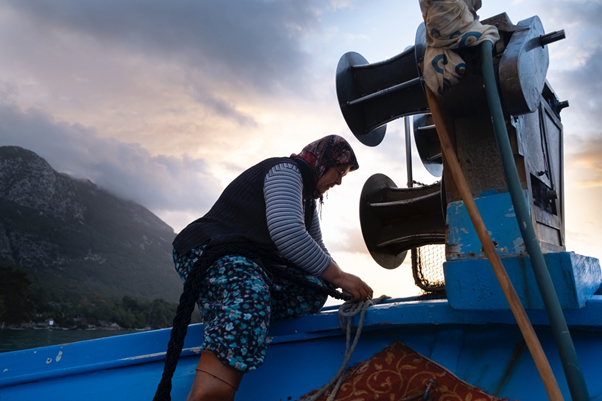
Gulsiye Olmez ©SPA/RAC, Bubi Film
"Gathering fishing nets in stormy weather and safely mooring the boat requires both strength and experience. Passing the necessary test and receiving a captain’s license is only one part of the equation. Practical experience is what makes a good captain", Ms. Olmez explains. Another important factor is the captain’s familiarity and understanding of the geography. "Back in the day we had a smaller boat. At times we would be out fishing for two to three days straight".
Born and raised in Gokova Bay, Gulsiye Olmez witnessed first-hand how the marine environment and fish populations changed over the years. Illegal and mass fishing practices reduced fish populations and damaged the biodiversity of the region.
Ms. Olmez believes that establishing No Fishing Zones will reverse this trend, improve fish populations and the livelihoods of traditional fishing communities. She believes that this can only be achieved through active management systems, such as the Mediterranean Conservation Society’s Marine Ranger Service System implemented in Gokova Bay, which tracks and stops illegal practices.
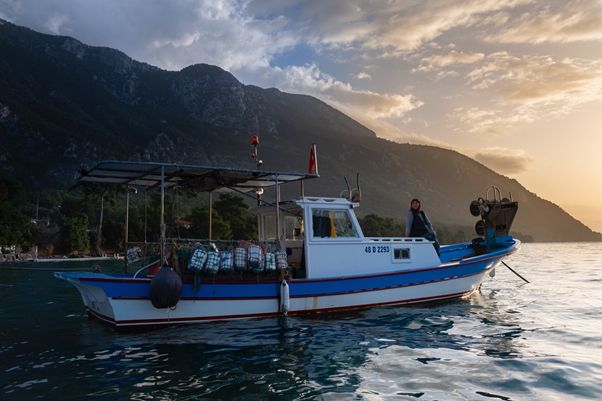
Gulsiye Olmez ©SPA/RAC, Bubi Film
The economic fallout from the COVID-19 pandemic has dealt a blow to her income due to lower market prices and rigid operating costs, but she remains optimistic: "the sea has the power to cure anything".
"Leaving the world’s troubles on shore, listening to the wind, and celebrating the catch", Ms. Olmez says, is "my sanctuary".
"Being a woman is hard, but being a fisherwoman makes life easier. Despite the physical challenges of this occupation, I think every woman should try it to make their life more beautiful", the Captain observes.
Gokova Bay, with a territorial area of 270 km² and sea area of 827 km², was declared a Special Environmental Protection Area (SEPA) in 1988, with 28 km² of this area accepted as a No Fishing Zone. Gokova Bay and its variety of marine habitats are home to the endemic sea grass Posidonia oceanica, and endangered species such as the grouper Epinephelus marginatus, the sand shark Carcharhinus plumbeus, and the Mediterranean monk seal Monachus monachus.
Mediterranean Conservation Society (MCS), with the support of local public institutions, has been implementing its Marine Ranger System (MRS) since 2013 to inspect and monitor illegal fishing activities in the No Fishing Zones (NFZs) in Gokova Bay. MRS and the other marine conservation projects implemented by MCS have contributed to restore the marine ecosystems in Gokova Bay. As a result, fish biomass in the NFZs increased 10fold when compared to unprotected areas. Furthermore, according to the data from Akyaka Fisheries Cooperative, since the establishment of NFZs in 2010, the incomes of fishers increased by 400 per cent.
Building on the success and experience gained through the Gokova Bay programme, MCS is now implementing an Endangered Landscapes Progamme in four MPAs in Turkey, in collaboration with Fauna & Flora International and the Ministry of Agriculture and Forestry, Ministry of Environment and Urban Planning, and Ministry of Interior of Turkey.
***
MPA-based entrepreneur turns invasive fish species into a local delicacy
A story from Kaş-Kekova, Turkey, prepared in collaboration with the Mediterranean Conservation Society (MCS) for the observance of the 2021 edition of International Women’s Day
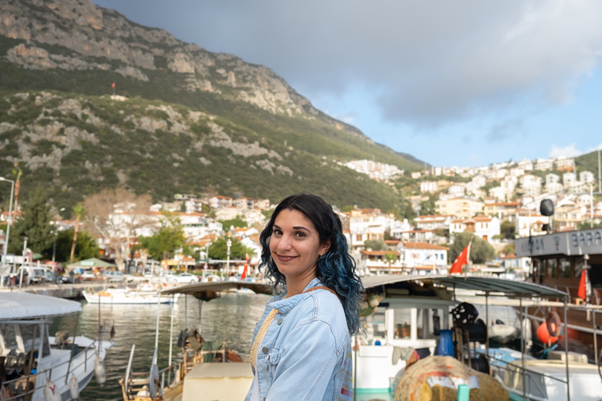
Kubra Karadayi Beyoglu ©SPA/RAC, Bubi Film
Two years ago, Kubra Karadayi Beyoglu and her husband left Istanbul and moved to the seaside town of Kaş where they opened a small restaurant. They cite that their fascination with the nature of the Kaş-Kekova marine protected area as the main reason for them setting up shop there.
As a green-minded entrepreneur, Ms. Karadayi Beyoglu runs "Zoka Street Food", the name she chose for her restaurant, on locally sourced produce of the season. Her days start with a morning visit to the local fish stalls. The day’s catch provides instant inspiration for the menu.
Delivering a new menu daily comes with challenges, but the Cheffe says she enjoys the process. This has allowed her to build rapport with the fishers and to better understand the mouth-watering wealth of local marine biodiversity.
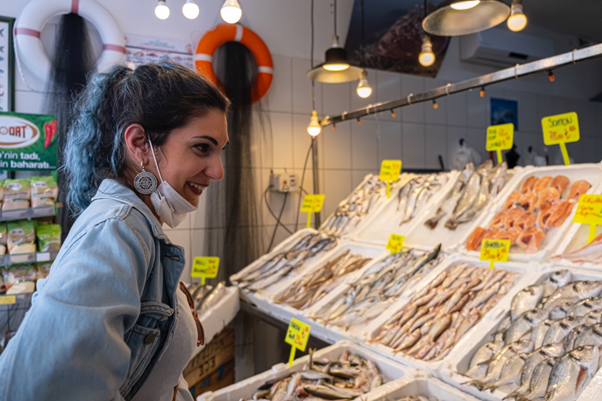
Fish market ©SPA/RAC, Bubi Film
The Kaş-Kekova waters have recently seen a spike in Non-Indigenous Species (NIS), including lionfish. Although it is edible, lionfish was little known by the local gluttons and had a somewhat frightful reputation. The entrepreneur still remembers the first time she was presented with a lionfish. "Don’t touch it or you’ll die", a fisher warned. "But as I did my own research and learned how to safely clean the fish, I realized it didn’t deserve all this aversion".
In a stroke of culinary genius, the innovative entrepreneur turned the lionfish into a local delicacy. Several other edible invasive species, including marbled and dusky spinefoot, soon followed lionfish on the journey from the waters of Kaş-Kekova to Ms. Karadayi Beyoglu’s restaurant. "People now come to our restaurant specifically for the invasive species we serve", she says.
When Kubra Karadayi Beyoglu first tastes a new entry on her NIS menu, she first familiarizes herself with the salt and fattiness levels of the fish and creates her recipes accordingly. For the lionfish, which is low in fat but potent in flavor, she recommends softening impact on the palate with a touch of fresh herbs and a juicy tartar.
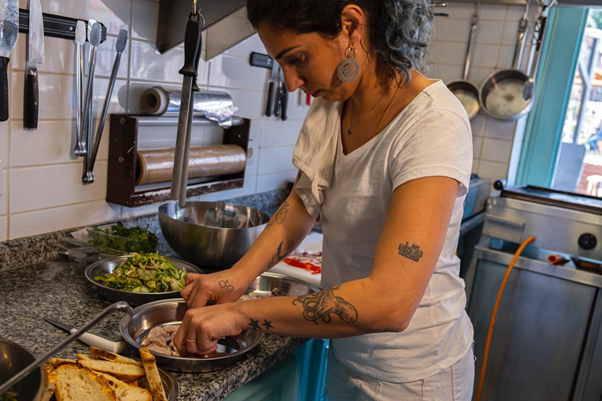
In the restaurant ©SPA/RAC, Bubi Film
As a business owner, Kubra understands that her restaurant is part of a local web of services, which is why she values collaborating with other restaurateurs, fishers and farmers. In addition to generating good business, putting non-indigenous fish on the menu relieves endemic species and turns a scourge into a bonanza. But for this to work in the long run, small-scale coastal fishers must want to target these species.
One of Ms. Karadayi Beyoglu’s dreams is to meet like-minded women entrepreneurs from other countries. She also believes that there are many chefs and cheffes in Turkey who would add lionfish to the menus they offer.
Restrictions related to the Covid-19 pandemic have impacted the business, so the restaurant started offering delivery services in order to stay "afloat". "I have started using social media to communicate with the customers, but it is not the same thing as welcoming them into my restaurant. The "don’t fear the lionfish" invitation to a new culinary experience works better with a reassuring smile.
![]() The Kaş-Kekova Marine Protected Area
The Kaş-Kekova Marine Protected Area
The Kaş-Kekova marine region covers a total of 258.30 km2, 92 km2 of which is designated as a Marine Protected Area (MPA). Studies show that 1000 marine species live in the Kaş-Kekova region.
To preserve and protect the marine ecosystem of this coastal region, the Mediterranean Conservation Society (MSC) is implementing a Marine Ranger System and other programmes under its Endangered Landscapes Programme. MSC is also partnering with UNDP GEF-Small Grants Programme on a project which promotes and conducts scientific research on the consumption of invasive alien species, aiming to reduce exogenous pressures on the marine ecosystem.
The views expressed do not necessarily represent the decision or the stated policy of the United Nations Environment Programme.



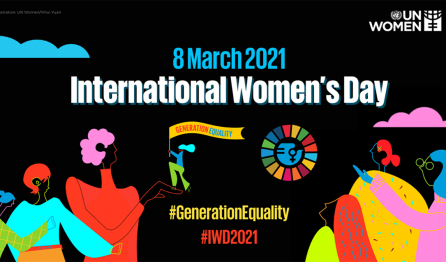
Suivez nous sur ...